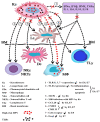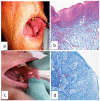Oral Papillomatosis: Its Relation with Human Papilloma Virus Infection and Local Immunity-An Update
- PMID: 36013570
- PMCID: PMC9415166
- DOI: 10.3390/medicina58081103
Oral Papillomatosis: Its Relation with Human Papilloma Virus Infection and Local Immunity-An Update
Abstract
Oral papilloma lesions may appear as a result of HPV infection, or not, and only special molecular methods could differentiate them. Low-risk and high-risk HPV types could induce oral HPV papillomatosis with different natural evolution, clearance and persistence mechanisms. The pathogenic mechanisms are based on the crosstalk between the oral epithelial and immune cells and this very efficient virus. HPV acts as a direct inducer in the process of transforming a benign lesion into a malignant one, the cancerization process being also debated in this paper. According to the degree of malignity, three types of papillomatous lesions can be described in the oral cavity: benign lesions, potential malign disorders and malignant lesions. The precise molecular diagnostic is important to identify the presence of various virus types and also the virus products responsible for its oncogenicity. An accurate diagnostic of oral papilloma can be established through a good knowledge of etiological and epidemiological factors, clinical examination and laboratory tests. This review intends to update the pathogenic mechanisms driving the macroscopic and histological features of oral papillomatosis having HPV infection as the main etiological factor, focusing on its interreference in the local immunity. In the absence of an accurate molecular diagnostic and knowledge of local immunological conditions, the therapeutic strategy could be difficult to decide.
Keywords: HPV immunity; HPV oncogenicity; HPV-related oral lesions; oral HPV infection; oral papilloma.
Conflict of interest statement
The authors declare no conflict of interest.
Figures




Similar articles
-
[Human papillomavirus (HPV) infection and its relation with squamous cell carcinoma of the mouth and oropharynx].Rev Assoc Med Bras (1992). 2004 Jul-Sep;50(3):252-6. doi: 10.1590/s0104-42302004000300029. Epub 2004 Oct 21. Rev Assoc Med Bras (1992). 2004. PMID: 15499474 Portuguese.
-
Human papilloma virus: An etiological and prognostic factor for oral cancer?J Investig Clin Dent. 2018 May;9(2):e12313. doi: 10.1111/jicd.12313. Epub 2018 Jan 10. J Investig Clin Dent. 2018. PMID: 29322686 Review.
-
Molecular events in the progression of recurrent respiratory papillomatosis to carcinoma.Arch Pathol Lab Med. 2002 Oct;126(10):1184-8. doi: 10.5858/2002-126-1184-MEITPO. Arch Pathol Lab Med. 2002. PMID: 12296755
-
Local immunological reactivity in oral squamous cell lesions of possible HPV (human papillomavirus) origin.Arch Geschwulstforsch. 1983;53(6):537-46. Arch Geschwulstforsch. 1983. PMID: 6322720
-
Focus on HPV Infection and the Molecular Mechanisms of Oral Carcinogenesis.Viruses. 2021 Mar 26;13(4):559. doi: 10.3390/v13040559. Viruses. 2021. PMID: 33810374 Free PMC article. Review.
Cited by
-
Analysis of Parents' Attitudes and Knowledge toward Immunization and How These Factors Influence Their Decisions to Vaccinate Their Children against Human Papilloma Virus (HPV).Medicina (Kaunas). 2023 Sep 30;59(10):1755. doi: 10.3390/medicina59101755. Medicina (Kaunas). 2023. PMID: 37893473 Free PMC article.
-
Association between Periodontal Disease and Oral Benign, Potentially Malignant, Malignant, and Chronic Immune-Mediated Disorders: A Clinical Study.Healthcare (Basel). 2024 Oct 7;12(19):1999. doi: 10.3390/healthcare12191999. Healthcare (Basel). 2024. PMID: 39408179 Free PMC article.
-
Screening for High-Risk Oral Human Papillomavirus (HPV31, HPV33, HPV35) in a Multi-Racial Pediatric and Adult Clinic Patient Population.Cancers (Basel). 2023 Sep 10;15(18):4501. doi: 10.3390/cancers15184501. Cancers (Basel). 2023. PMID: 37760471 Free PMC article.
-
Unveiling the Human Gastrointestinal Tract Microbiome: The Past, Present, and Future of Metagenomics.Biomedicines. 2023 Mar 9;11(3):827. doi: 10.3390/biomedicines11030827. Biomedicines. 2023. PMID: 36979806 Free PMC article. Review.
-
An exploration of the natural and acquired immunological mechanisms to high-risk human papillomavirus infection and unmasking immune escape in cervical cancer: A concise synopsis.Tzu Chi Med J. 2024 Dec 3;37(1):28-41. doi: 10.4103/tcmj.tcmj_134_24. eCollection 2025 Jan-Mar. Tzu Chi Med J. 2024. PMID: 39850385 Free PMC article. Review.
References
-
- Sabry A.O., Patel B.C. StatPearls. StatPearls Publishing; Treasure Island, FL, USA: 2022. [(accessed on 17 June 2022)]. Papilloma. Available online: https://www.ncbi.nlm.nih.gov/books/NBK560737/
-
- Gupta I., Jabeen A., Al-Sarraf R., Farghaly H., Vranic S., Sultan A.A., Al Moustafa A.-E., Al-Thawadi H. The co-presence of high-risk human papillomaviruses and Epstein-Barr virus is linked with tumor grade and stage in Qatari women with breast cancer. Hum. Vaccin. Immunother. 2021;17:982–989. doi: 10.1080/21645515.2020.1802977. - DOI - PMC - PubMed
Publication types
MeSH terms
LinkOut - more resources
Full Text Sources
Medical

